The next target was at 3,238 to 3,240. The high this session at 3,240.48 meets expectations.
Summary: Assume the trend remains the same until proven otherwise. Assume more upwards movement to the next short-term target at 3,268.
If price makes a new low now below 3,220.51, then assume minor wave 4 has arrived. Minor wave 4 should last about two weeks or so and may end somewhere within the range of 3,154.26 to 3,070.49 (the upper edge of this range is preferred).
Thereafter, the next target is at 3,302 for a larger fourth wave correction and then 3,336 for an even larger fourth wave correction.
Three large pullbacks or consolidations (fourth waves) during the next 1-2 years are expected: for minor wave 4 (coming soon), then intermediate (4), and then primary 4. Some weakness prior to each of these corrections may be evident in technical analysis. Weakness is now evident in VIX, and conditions are becoming extreme. Extreme conditions warrant more careful attention to risk management at this time.
The biggest picture, Grand Super Cycle analysis, is here.
Monthly charts were last published here, with video here. There are two further alternate monthly charts here, with video here.
ELLIOTT WAVE COUNTS
The two weekly Elliott wave counts below will be labelled First and Second. They may be about of even probability. When the fifth wave currently unfolding on weekly charts may be complete, then these two wave counts will diverge on the severity of the expected following bear market. To see an illustration of this future divergence monthly charts should be viewed.
FIRST WAVE COUNT
WEEKLY CHART
The basic Elliott wave structure consists of a five wave structure up followed by a three wave structure down (for a bull market). This wave count sees the bull market beginning in March 2009 as an incomplete five wave impulse and now within the last fifth wave, which is labelled cycle wave V. This impulse is best viewed on monthly charts. The weekly chart focusses on the end of it.
Elliott wave is fractal. This fifth wave labelled cycle wave V may end a larger fifth wave labelled Super Cycle wave (V), which may end a larger first wave labelled Grand Super Cycle wave I.
The teal Elliott channel is drawn using Elliott’s first technique about the impulse of Super Cycle wave (V). Draw the first trend line from the end of cycle wave I (off to the left of the chart, the weekly candlestick beginning 30th November 2014) to the end of cycle wave III, then place a parallel copy on the end of cycle wave II. This channel perfectly shows where cycle wave IV ended at support. The strongest portion of cycle wave III, the end of primary wave 3, overshoots the upper edge of the channel. This is a typical look for a third wave and suggests the channel is drawn correctly and the way the impulse is counted is correct.
Within Super Cycle wave (V), cycle wave III is shorter than cycle wave I. A core Elliott wave rule states that a third wave may never be the shortest. For this rule to be met in this instance, cycle wave V may not be longer in length than cycle wave III. This limit is at 3,477.39.
Cycle wave V may subdivide either as an impulse or an ending diagonal. Impulses are much more common. An alternative wave count which considered an ending diagonal has been invalidated. While it is possible a diagonal may become an alternate wave count in coming weeks or months, at this stage the structure does not fit.
At this stage, cycle wave V may take another one to two or so years to complete.
The daily chart below will focus on movement from the end of intermediate wave (2) within primary wave 3.
In historic analysis, two further monthly charts have been published that do not have a limit to upwards movement and are more bullish than this wave count. Members are encouraged to consider those possibilities (links below summary) alongside the wave counts presented on a daily and weekly basis. It is my judgement that the two weekly wave counts published in this analysis have the highest probability, so they shall be the only wave counts published on a daily basis.
Within cycle wave V, primary waves 1 and 2 may be complete. Within primary wave 3, intermediate waves (1) and (2) may be complete. Within the middle of intermediate wave (3), no second wave correction may move beyond its start below 2,855.96.
DAILY CHART
All of primary wave 3, intermediate wave (3) and minor wave 3 may only subdivide as impulses.
Minor wave 3 has passed 1.618 the length of minor wave 1, and within it minute wave v has passed equality in length with minute wave i. If minute wave v ends here, then it would be 1.66 points longer than 1.618 the length of minute wave i.
Today it is possible that minute wave v within minor wave 3 may be complete.
Minor wave 2 was a sharp deep pullback, so minor wave 4 may be expected to be a very shallow sideways consolidation to exhibit alternation. Minor wave 2 lasted 2 weeks. Minor wave 4 may be about the same duration, or it may be a longer lasting consolidation. Minor wave 4 may end within the price territory of the fourth wave of one lesser degree; minute wave iv has its range from 3,154.26 to 3,070.49.
Minor wave 4 may not move into minor wave 1 price territory below 3,021.99.
Intermediate wave (3) has now moved far enough above the end of intermediate wave (1) to allow intermediate wave (4) to unfold and remain above intermediate wave (1) price territory.
Draw an acceleration channel now about intermediate wave (3): draw the first trend line from the end of minor wave 1 to the last high, then place a parallel copy on the end of minor wave 2. Keep redrawing the channel as price continues higher. When minor wave 3 is complete, then this channel would be an Elliott channel and may show where minor wave 4 may find support if it is long lasting or deep enough.
HOURLY CHART
The hourly chart will now focus on minute wave v.
Always assume a trend remains the same until proven otherwise. At this stage, this market is in a clear upwards trend that is not yet extreme.
Within minute wave v, minuette waves (i) through to (iv) may now all be complete. Minuette wave (v) shows a small decline in momentum; this wave count still fits with MACD. Price remains within the best fit channel.
The degree of labelling within minuette wave (v) is moved down one degree. Minuette wave (v) must subdivide as a five wave structure, and within it subminuette wave ii may not move beyond the start of subminuette wave i below 3,220.51. A new low below this point would also necessitate a breach of the best fit channel, so a trend change would then be indicated.
If the degree of labelling within minuette wave (v) is moved up one degree, then it is possible that minor wave 3 may be a complete structure at all wave degrees.
SECOND WAVE COUNT
WEEKLY CHART
This weekly chart is almost identical to the first weekly chart, with the sole exception being the degree of labelling.
This weekly chart moves the degree of labelling for the impulse beginning in March 2009 all down one degree. This difference is best viewed on monthly charts.
The impulse is still viewed as nearing an end; a fifth wave is still seen as needing to complete higher. This wave count labels it primary wave 5. Primary wave 5 may still need another year to two or so to complete, depending upon how time consuming the corrections within it may be.
Primary wave 5 may be subdividing as an impulse, in the same way that cycle wave V is seen for the first weekly chart.
TECHNICAL ANALYSIS
MONTHLY CHART
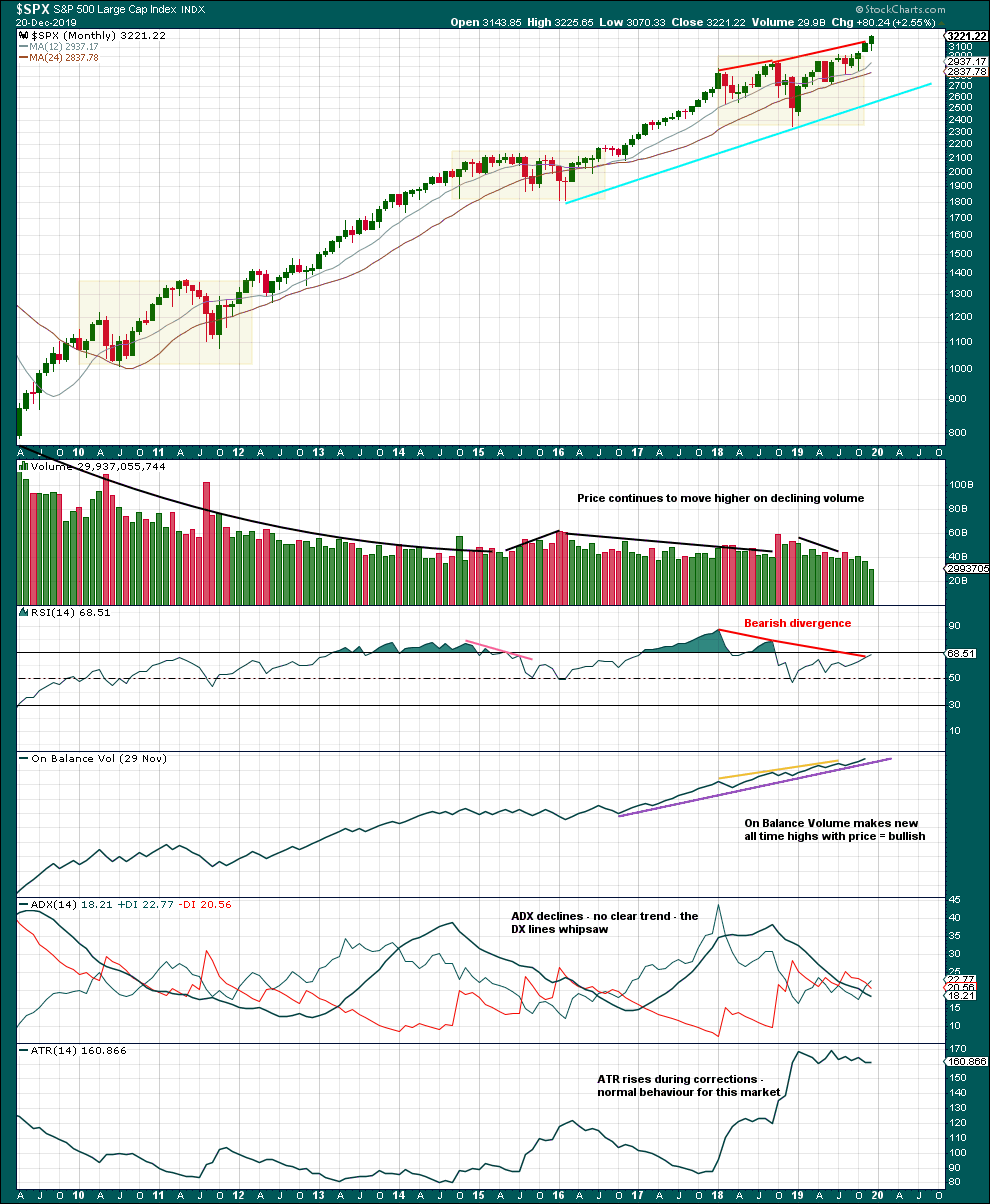
Click chart to enlarge. Chart courtesy of StockCharts.com.
There are three large consolidations noted on this chart, in shaded areas. After a breakout from a multi-month consolidation, it is reasonable to expect a multi month bullish move may result.
This chart very clearly exhibits rising price on declining volume has now persisted for several years. A decline in volume last month, in current market conditions, is not of concern.
On Balance Volume supports the Elliott wave count.
WEEKLY CHART
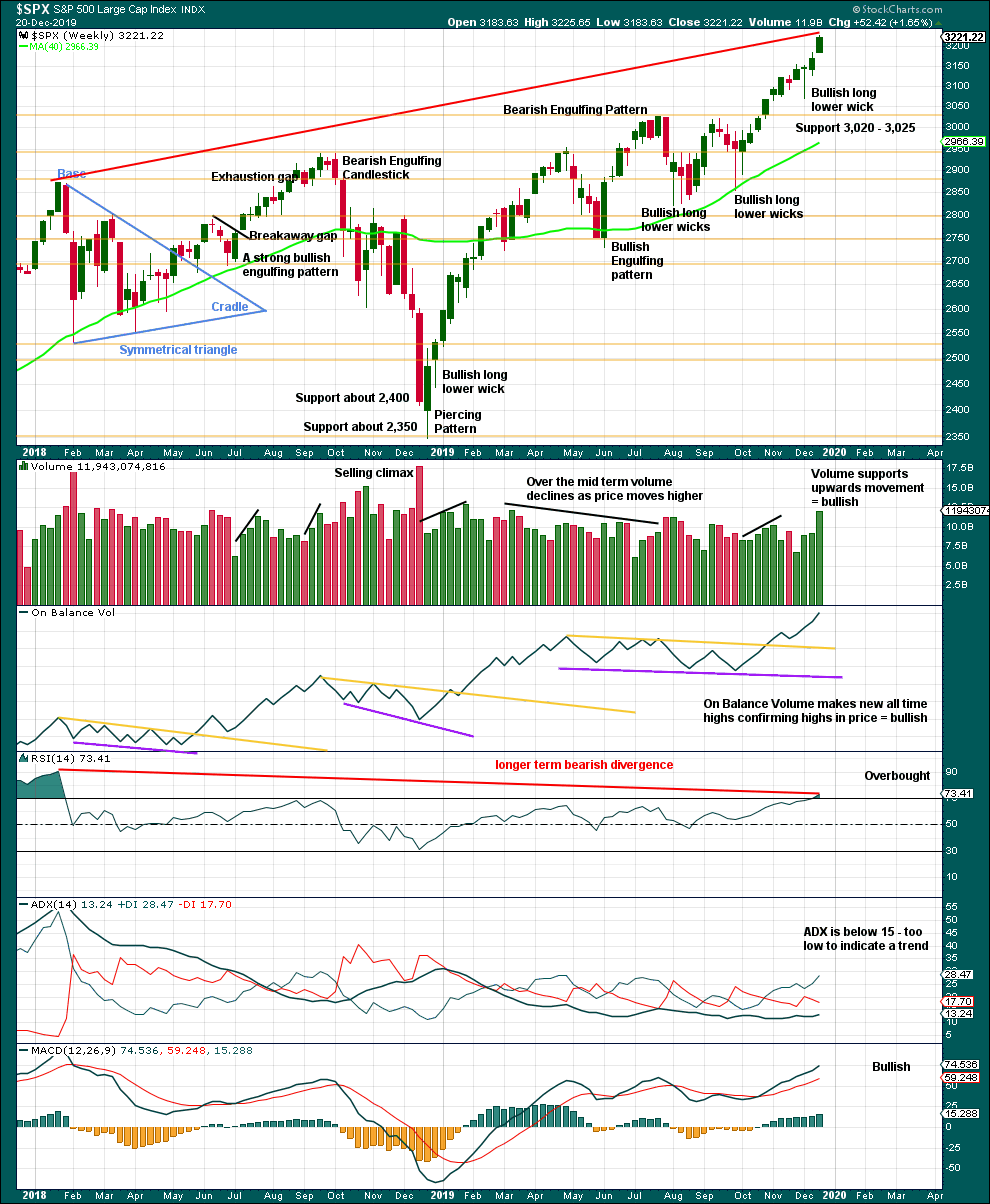
Click chart to enlarge. Chart courtesy of StockCharts.com.
It is very clear that the S&P is in an upwards trend and the bull market is continuing. Price does not move in straight lines; there will be pullbacks and consolidations along the way.
This chart is overall bullish. There are no signs of weakness in upwards movement.
Last week RSI reaches into overbought. That does not mean upwards movement must end here, because it can continue for several weeks while RSI reaches more extreme. RSI reaching into overbought is a warning that conditions are now becoming extreme. A pullback or consolidation will follow and the longer conditions are extreme the closer this will be. However, assume the trend remains the same until proven otherwise. This warning should be heeded by careful attention to risk management.
DAILY CHART
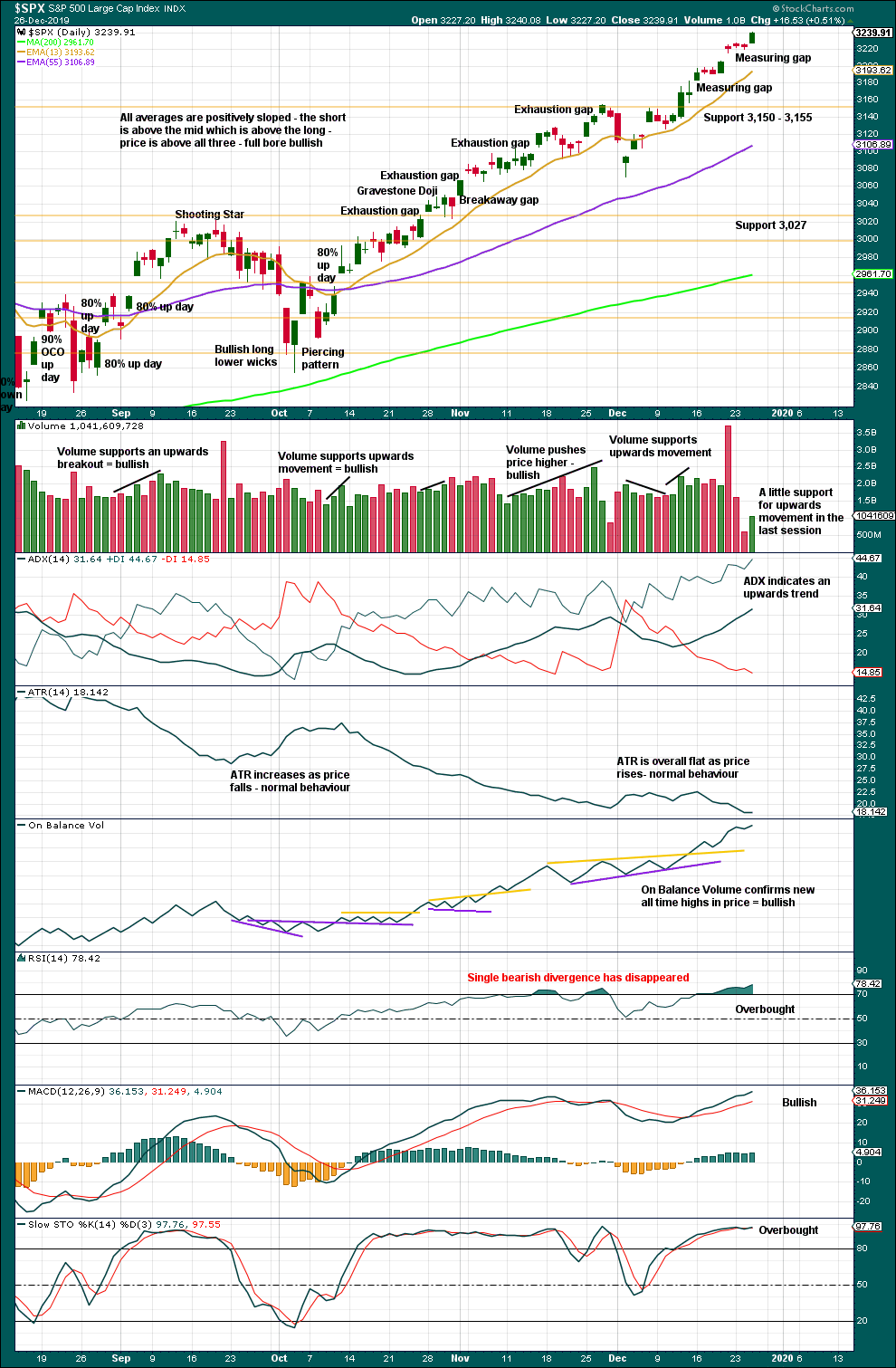
Click chart to enlarge. Chart courtesy of StockCharts.com.
There is an upwards trend in place. There will be corrections along the way.
Like the weekly chart, this chart is bullish.
With RSI overbought at both daily and weekly time frames, members are advised to pay careful attention to risk management. A larger pullback or consolidation will come to relieve extreme conditions. A bearish signal in the form of a candlestick reversal pattern, a 90% downwards day, strong bearish divergence in On Balance Volume or the AD line, or a combination of these signals, will be looked for. No bearish reversal signs are evident so far.
There is still room for this upwards trend to continue.
The measuring gap at 3,240 remains valid. Now another gap gives a second target at 3,230, which was today met and exceeded.
When this market trends, Stochastics may remain overbought for a very long time. Stochastics should be used to identify swings within a consolidation and not extremes of bull and bear trends.
This trend is not yet extreme. There is room for it to continue further. This market does not always give bearish signals just prior to an end to upwards trends. They can come along suddenly.
BREADTH – AD LINE
WEEKLY CHART
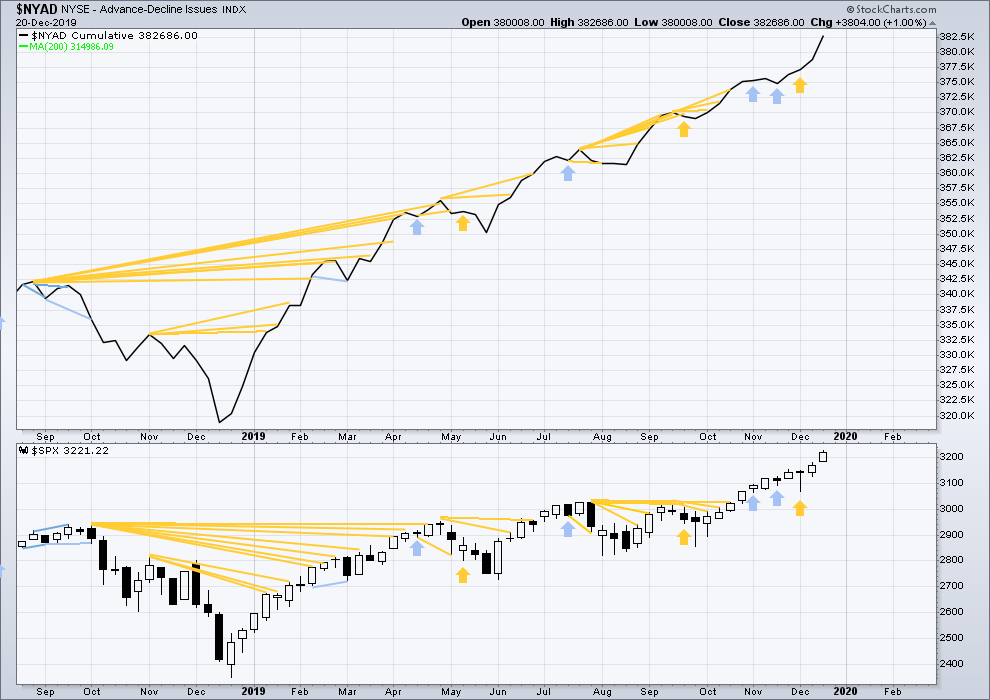
Click chart to enlarge. Chart courtesy of StockCharts.com. So that colour blind members are included, bearish signals
will be noted with blue and bullish signals with yellow.
Bear markets from the Great Depression and onwards have been preceded by an average minimum of 4 months divergence between price and the AD line with only two exceptions in 1946 and 1976. With the AD line making new all time highs last week, the end of this bull market and the start of a new bear market is very likely a minimum of 4 months away, which is mid March 2020.
In all bear markets in the last 90 years there is some positive correlation (0.6022) between the length of bearish divergence and the depth of the following bear market. No to little divergence is correlated with more shallow bear markets. Longer divergence is correlated with deeper bear markets.
If a bear market does develop here, it comes after no bearish divergence. It would therefore more likely be shallow.
All of small, mid and large caps have made new swing highs above the prior swing high on the 13th of September, and mid caps have now made new all time highs. This upwards movement appears to be mostly driven by large caps, which is a feature of aged bull markets. This bull market at over 10 years duration certainly fits the definition of aged.
Again both price and the AD line have made new all time highs. There is no divergence. Upwards movement has support from rising market breadth.
Large caps all time high: 3,225.54 on 20th December 2019.
Mid caps all time high: 2,069.95 on 20th December 2019.
Small caps all time high: 1,100.58 on 27th August 2018.
DAILY CHART
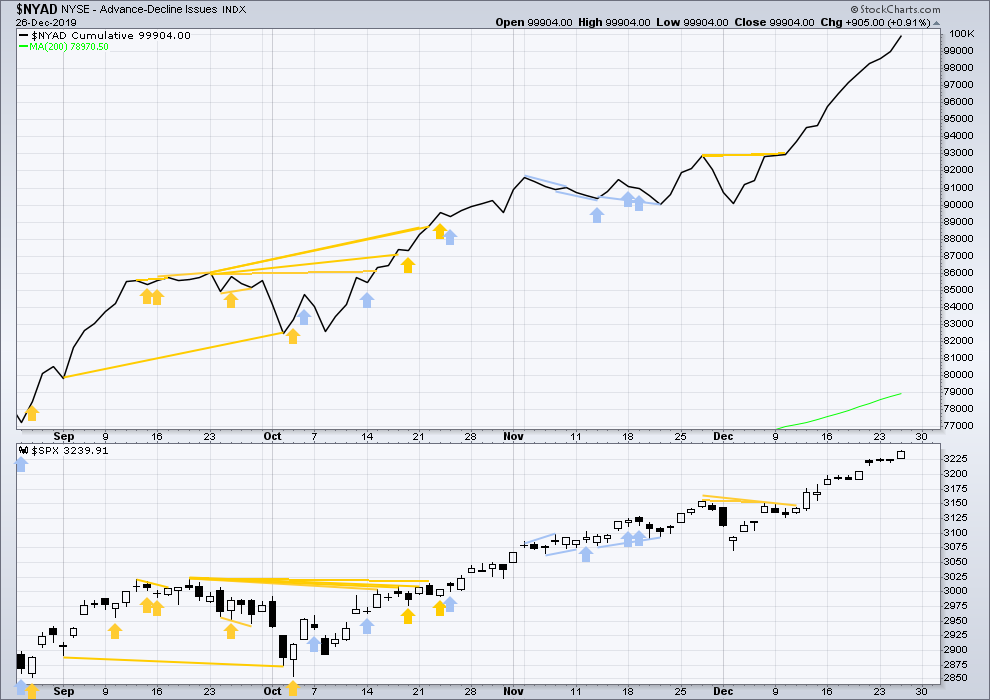
Click chart to enlarge. Chart courtesy of StockCharts.com. So that colour blind members are included, bearish signals
will be noted with blue and bullish signals with yellow.
Breadth should be read as a leading indicator.
On Friday price has moved higher but failed by a very small margin to make a new all time high. The AD line has moved higher to make a new all time high but only by a very small margin. This divergence is bullish, but it is weak.
Again both price and the AD line have made new all time highs. Upwards movement has support from rising market breadth. This is bullish.
VOLATILITY – INVERTED VIX CHART
WEEKLY CHART

Click chart to enlarge. Chart courtesy of StockCharts.com. So that colour blind members are included, bearish signals
will be noted with blue and bullish signals with yellow.
The all time high for inverted VIX was on 30th October 2017. There is now over two years of bearish divergence between price and inverted VIX.
The rise in price is not coming with a normal corresponding decline in VIX; VIX remains elevated. This long-term divergence is bearish and may yet develop further as the bull market matures.
This divergence may be an early warning, a part of the process of a top developing that may take years. It may is clearly not useful in timing a trend change from bull to a fully fledged bear market.
Last week price makes new highs, but inverted VIX does not. There is now short, mid and long-term bearish divergence between price and inverted VIX.
DAILY CHART
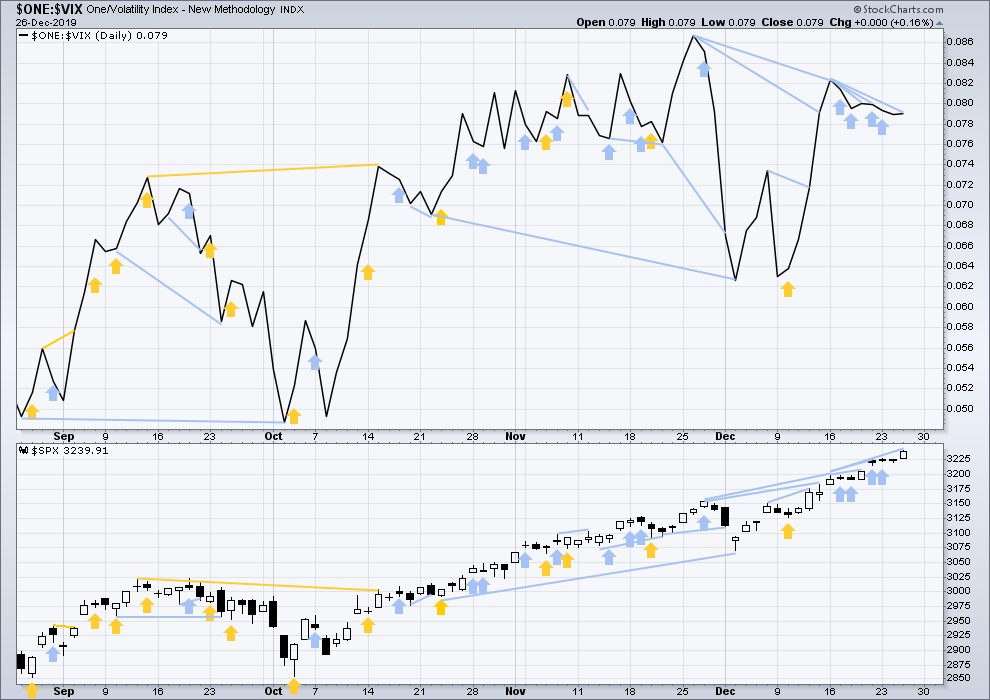
Click chart to enlarge. Chart courtesy of StockCharts.com. So that colour blind members are included, bearish signals
will be noted with blue and bullish signals with yellow.
Both price and inverted VIX have moved higher today. Price has made new all time highs, but there remains all of short, mid and long-term bearish divergence with inverted VIX.
DOW THEORY
Dow Theory confirmed a bear market in December 2018. This does not necessarily mean a bear market at Grand Super Cycle degree though; Dow Theory makes no comment on Elliott wave counts. On the 25th of August 2015 Dow Theory also confirmed a bear market. The Elliott wave count sees that as part of cycle wave II. After Dow Theory confirmation of a bear market in August 2015, price went on to make new all time highs and the bull market continued.
DJIA: 23,344.52 – a close on the 19th of December at 23,284.97 confirms a bear market.
DJT: 9,806.79 – price has closed below this point on the 13th of December.
S&P500: 2,532.69 – a close on the 19th of December at 2,506.96 provides support to a bear market conclusion.
Nasdaq: 6,630.67 – a close on the 19th of December at 6,618.86 provides support to a bear market conclusion.
With all the indices having moved higher following a Dow Theory bear market confirmation, Dow Theory would confirm a bull market if the following highs are made:
DJIA: 26,951.81 – a close above this point has been made on the 3rd of July 2019.
DJT: 11,623.58 – to date DJT has failed to confirm an ongoing bull market.
S&P500: 2,940.91 – a close above this point was made on the 29th of April 2019.
Nasdaq: 8,133.30 – a close above this point was made on the 26th of April 2019.
Published @ 10:25 p.m. EST.
—
Careful risk management protects your trading account(s).
Follow my two Golden Rules:
1. Always trade with stops.
2. Risk only 1-5% of equity on any one trade.
—
New updates to this analysis are in bold.

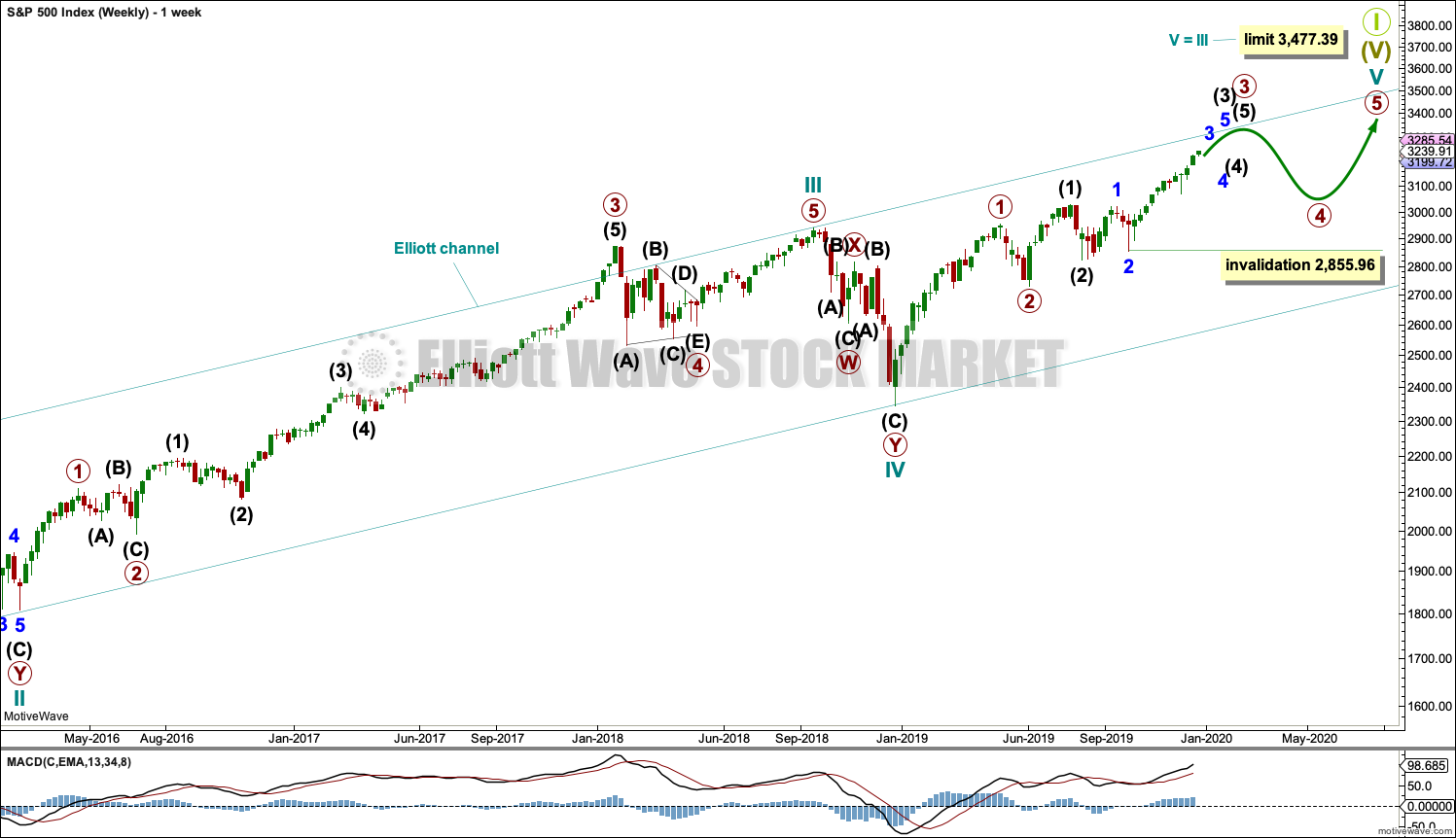
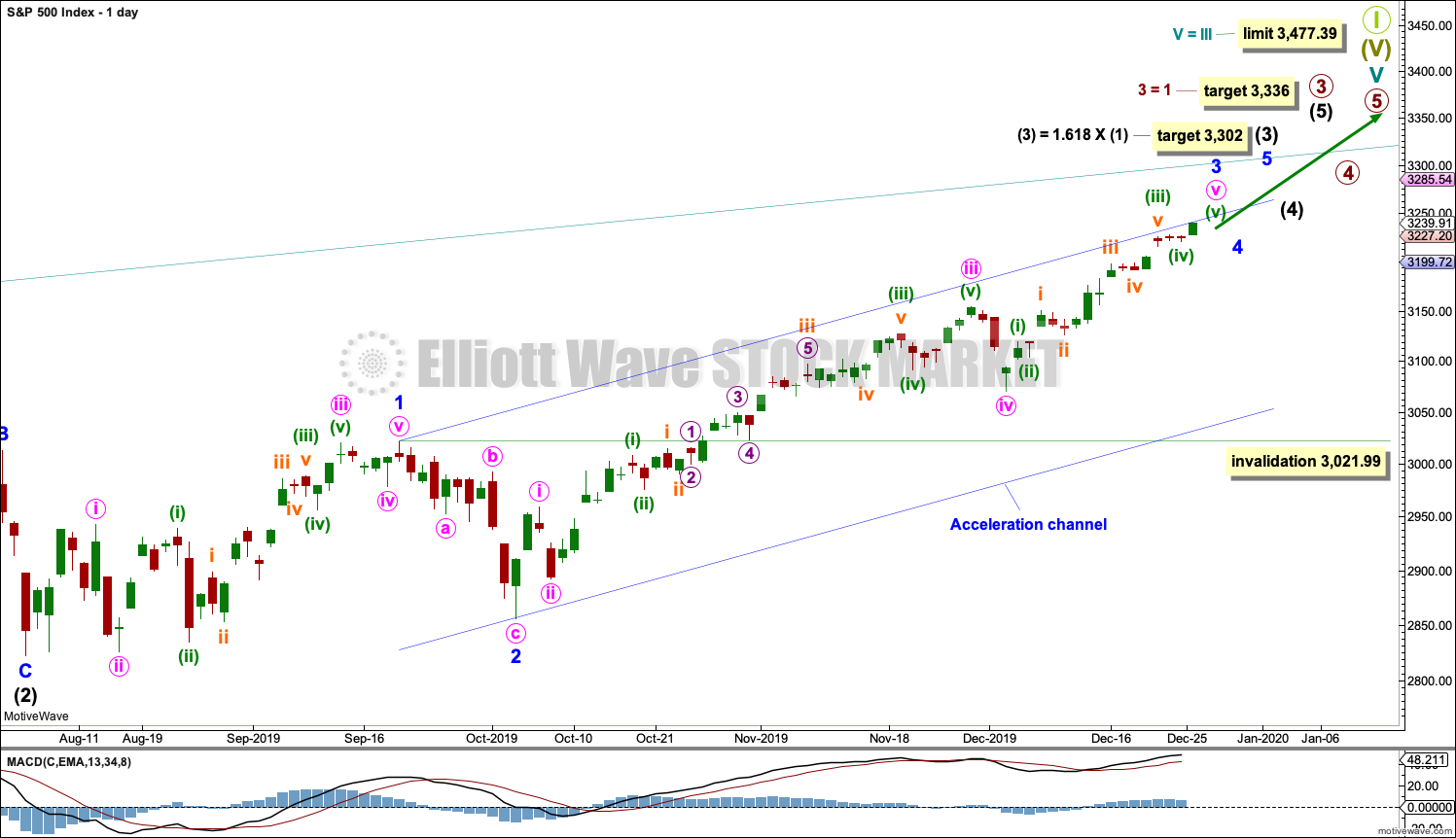
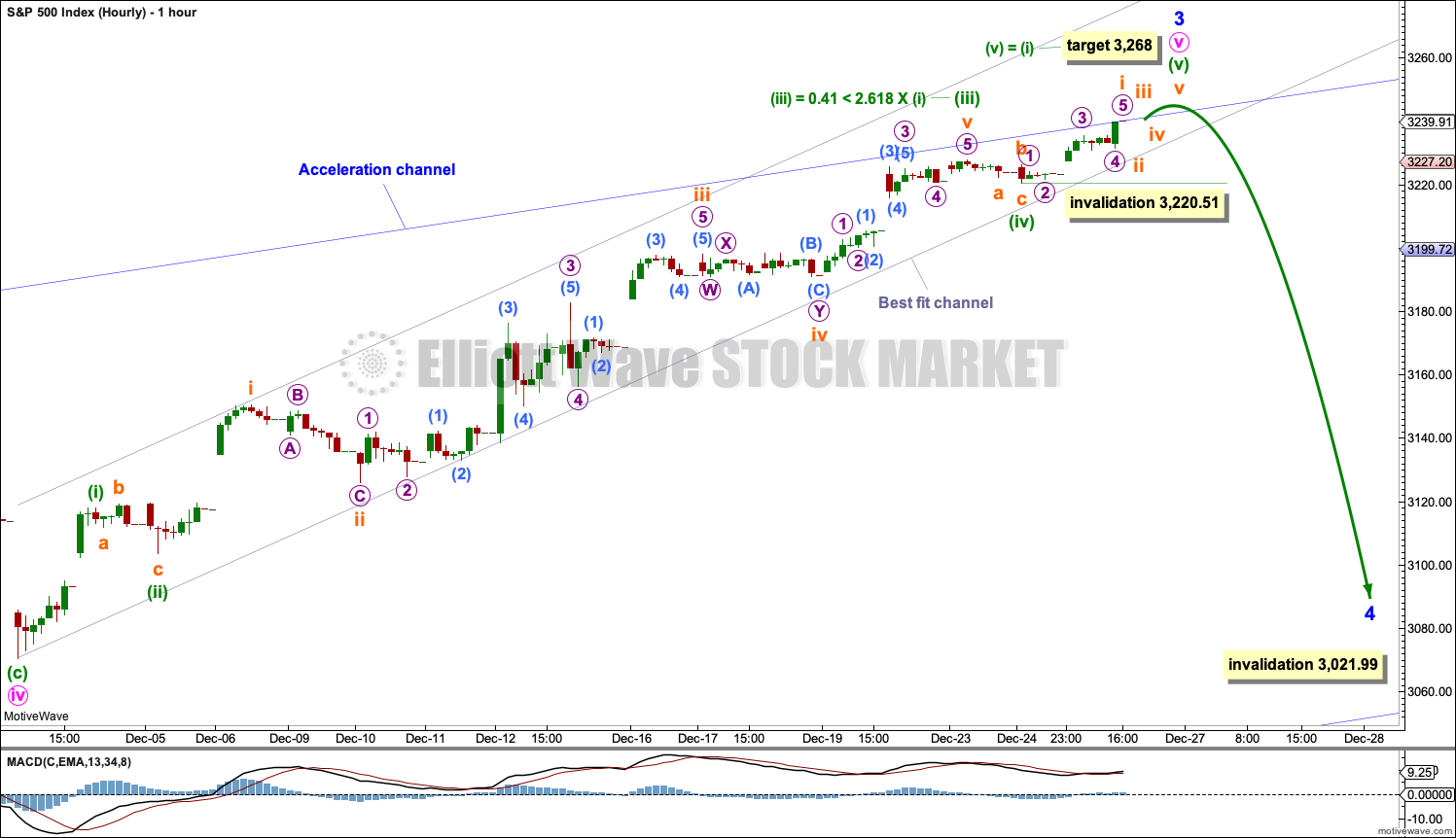
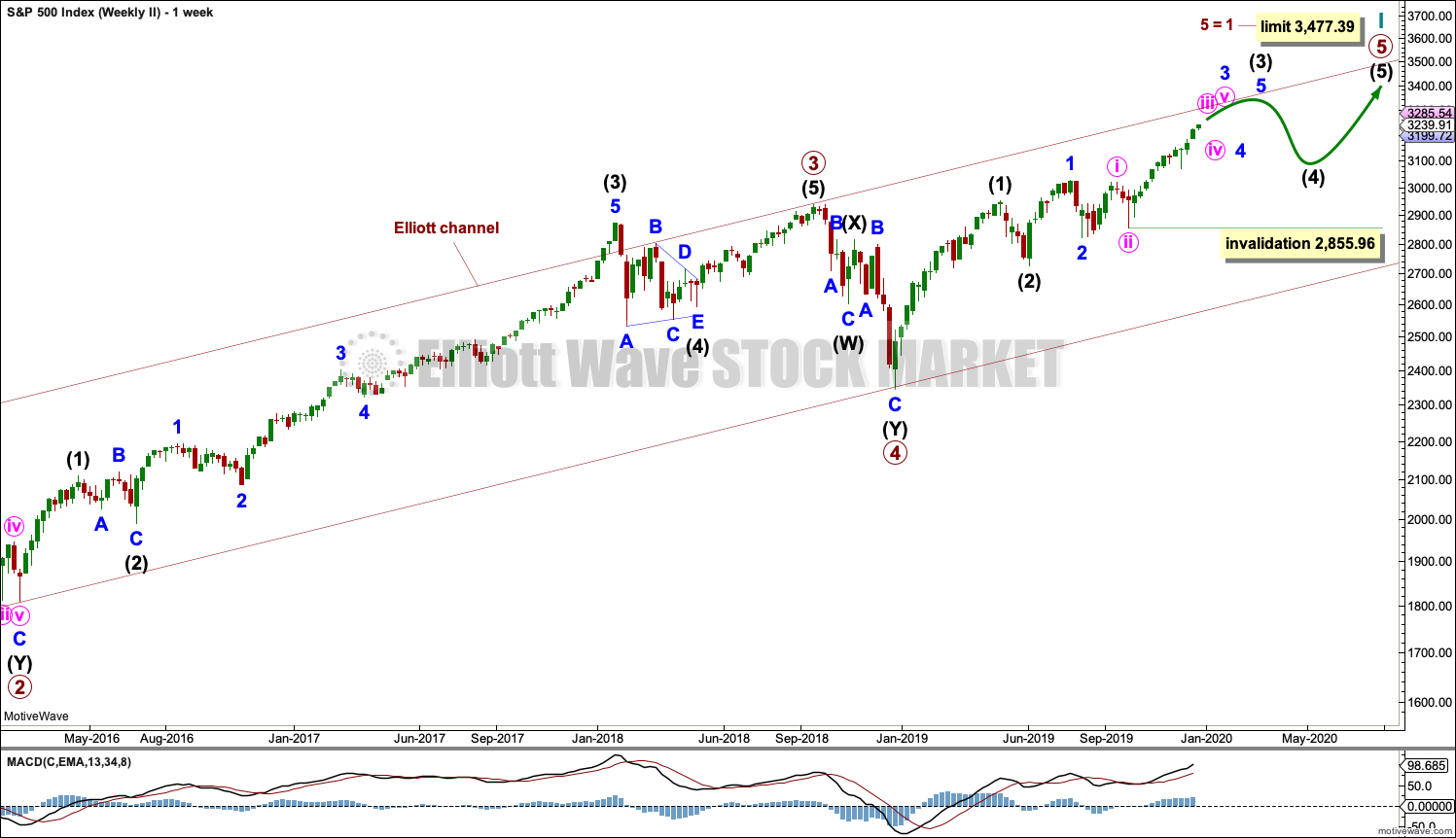
A larger correction is now getting closer and closer but no indication it’s arrived today. Yet.
Assume the trend remains the same, until proven otherwise. Assume minor 3 continues higher while price remains within the grey narrow Best Fit channel.
We are at “Extreme Greed” on the Fear/Greed Index. Getting close to a correction.
https://money.cnn.com/data/fear-and-greed/
We may get (may!) a dark cloud cover bar here today. Though I suspect a 12/31 date for a final ATH before the start of the minor 4 is likely. My finger is over the “short” button!!!! I want to hit it…but I’m holding off. Gotta see some indication of a turn first. Looking to sell SPX call spreads for Jan 17 3300/3305 for $1.10. The “risk profile” odds (odd per the recent volatility levels and assuming random price action) put that as a winning trade 71% of the time. If we assume our EW knowledge cuts our potential to be “wrong” by 50%, that means the odds of losing are about 15% only in this trade. The average win size is $110. The average loss size by using a stop at the breakeven level of 3300 is -$171. That’s a per trade expected value of +$68 per spread. Gotta like that. What I like even more is trade structure itself largely eliminates the entire problem of “should I exit now???”, which is a consistent question in positional trades. With sold spreads, you just wait, unless you get to perhaps 80% or more of the your max profits early, in which case, taking it and recycling the money into a trade that will accrue more/faster than what remains in this one is an easy decision.
Here’s RUT. Two pieces of evidence that suggest a few more days of up. First, the count I have here is incomplete; we need the end of the current iv wave, then a v up to finish this. Secondly, the current high has a relatively poor fit of the entire swing structure to a Fibonacci structure. The fit gets quite good at the level I’ve placed the structure here, which is “just a little higher” than the current highs. So the indication here as I see it is for a little more upwards push early next week, THEN it’s over. Maybe starting Jan 2 with some serious selling. BTW, John Carter just put our a free video with the exact same expectation (for totally different specific reasons, he’s not an EW’er or much of a Fibo structure guy), top on the 31st then start of several weeks of correction.
Okay, I took a small initial short in both RUT and SPX here. Sold overhead call spreads for Jan 17, 3300/3305 in SPX and 1705/1710 in RUT. Hopefully high enough to avoid a stop out if price pushes a bit higher here first in the next couple of days. Once the minor 4 starts with vigor, I will double up at least.
Full disclosure: I also hold Jan 17 longs via deep out of the money sold put spreads. Those should be safe from all minor 4 action, so I’m just holding those for the very likely profits in only 3 weeks. And depending, I might even add to these if price gets low enough. So effectively I end up with a kind of sold iron condor profit and loss profile, with sold call spread above and sold put spread below.
Anyone remember what days Lara was going to be on holiday? I am thinking it was starting right about now.
It’s been and gone Rodney. I had Christmas Day and Boxing Day off. And I surfed my little heart out!
Hi Lara,
as your upper targets have extended up, I notice that the wave 4 correction targets basically stay the same. are the new upper target levels, 3268, based on fib levels or wave 1 correlation? if spx continues to move higher, would wave 4 consolidation target levels also float higher in congruence?
Not sure where you are seeing minor 4 “target” prices at this point; I only see the model invalidation level (where the minor 4 would cross below the minor 1 high). That level won’t change until the entire minor 4 model changes; unlikely at this point.
As for target, the general EW target for a 4 wave is the iv wave of one lower degree, so in this case of a minor 4, the minute iv wave of the preceding minor 3. The range of that is 3070-3154. And that also won’t change…unless a “remodeling” of the entire wave 3 necessary.
Given how far this minute v is extending, it is setting up a rather large (as in deep) minor 4!!!
The expected range for minor 4 will remain the fourth wave of one lesser degree price territory. Minute iv is complete, and it’s territory won’t change (unless the whole count changes).
But the higher minor 3 goes, the higher any expectation for minor 4 should be, yes.
I can’t give you targets for minor 4 until we know that minor 3 has ended and I can then draw a Fibonacci retracement along the length of minor 3. That can’t be done yet.
My SPX view and my /ES views. The lines are projections of prior sub-swings in the minor 3 so far. It’ll turn when it’ll turn…
And /ES, pushing up strong overnight. The higher target I put down a few weeks ago, the lower just now.
Grabbing the pole position. Yippee!
Lara, you wrote, “This market does not always give bearish signals just prior to an end to upwards trends. They can come along suddenly.”
That is most certainly true and we have seen evidence of this at least two times in the last 14 months. Corrections seem to have started with little or no bearish signals.
This past year has been very good for me in my long term account. In fact, I have reached a milestone. My first goal for retirement has been met. I can retire now. But I will work at least two more years. I will be working on retirement goal #2 which is reasonably within reach. Thanks for your help in reaching this milestone.
Happy New year to all.
Congrats Rodney!
A very disciplined demonstration of positional trading with (accurate!) EW counts.
that is amazing news congratulations!
That’s excellent Rodney. I am very happy to have been a small help in your milestone, but I’m sure most of it was your own trading discipline and experience.
Happy New Year to you too!